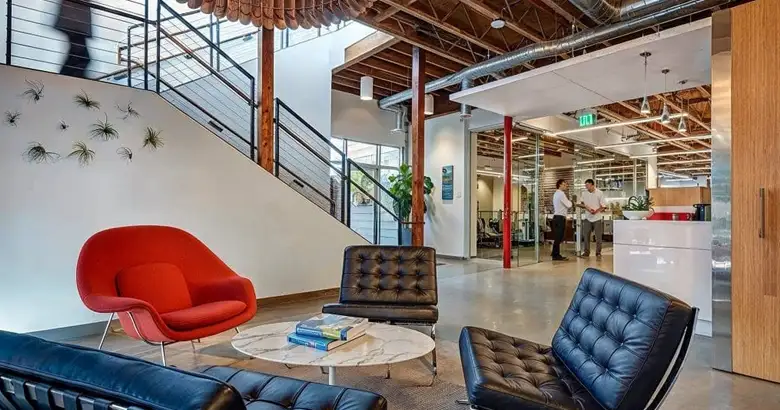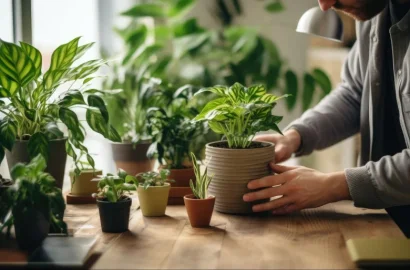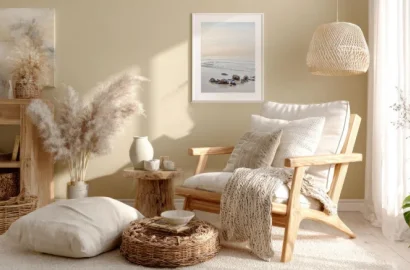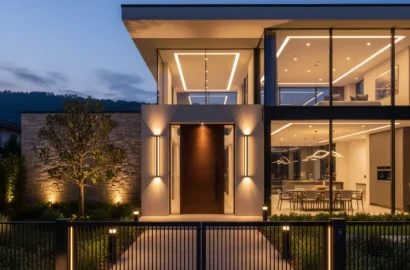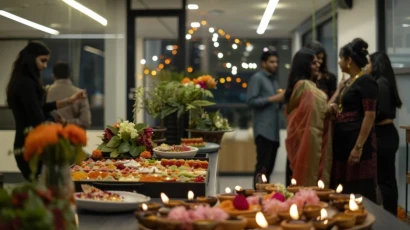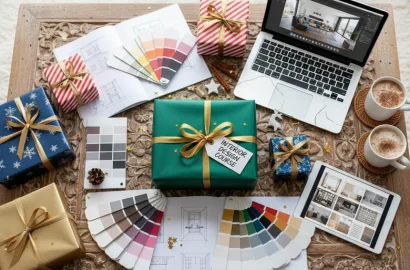Curious about spatial design? Understand what it encompasses, discover the latest trends, and find inspiration from tangible examples.
Any space you encounter has the potential to tell stories, evoke emotions, and affect how you feel. The structure of spaces focuses on the entire experience delivered by the built environment, including external factors that influence how you interact with them. It considers everything from the structural layout to the sensory experiences that a space and its surroundings have to offer.
In this comprehensive guide, we’ll explore spatial design in detail, understand how it differs from interior design, and showcase real-world examples that demonstrate its application in creating user-centric spaces.
Here’s a clickable link to everything we’ll be covering in this article!
- What does spatial design mean?
- Essential components of spatial design
- How is spatial design different from interior design?
- Technological advancements in spatial design
- Latest trends in spatial design
- Examples of spatial design
- How to become a spatial designer?
- Final thoughts
What Does Spatial Design Mean?
Spatial design is a discipline that deals with designing meaningful and aesthetic spaces, focusing on how they are organized, the way they make people feel, and how they might improve the lives of those experiencing them. It is the study of how people move and interact within spaces and ways to enrich their experiences through design.
It poses questions that can influence the way people feel in different contexts, such as, what makes a space feel safe, comfortable, or culturally relevant? Unlike traditional design fields that may focus on specific elements like structures or interiors, spatial design takes a holistic approach. It considers factors like ergonomics, comfort, accessibility, sustainability, human behavior, and cultural context when organizing and arranging spaces.
Spatial designers may combine layout design, spatial planning, lighting design, material selection, and cognitive integration to create engaging spaces that improve user experiences. They often collaborate with architects, set designers, and other specialists to implement their projects.

Essential Components of Spatial Design
There are several important factors that you need to consider in spatial design to ensure that you fulfill the functional and aesthetic requirements of the project. Here are the factors you need to prioritize:
1. Function
Every design decision for a space needs to support its purpose effectively. It’s important to think about how people will use the space, what problem it will solve, and how it will justify their needs and support their activities.
2. Layout design
The way a space is planned and arranged determines how it is experienced. Pay attention to zoning and circulation patterns to ensure you are able to accommodate specific requirements with maximum comfort and usability. This may involve defining the location of activities, placing furniture, and optimizing a smooth flow within the space.
3. Aesthetic consideration
The visual appeal of spatial designs is equally important and significantly impacts the user experience. Consider elements like color schemes, textures, form, composition, and visual hierarchy to create meaningful and aesthetic designs.
4. Scale and proportion
The scale and proportion of elements should feel appropriate based on their distance from the users, maintaining a sense of balance and usability. Ensure that furniture, architectural features, and other design elements are appropriately sized relative to the space and each other.
5. Materials and finishes
Select materials and finishes that complement the function of the space and contribute to its aesthetic appeal. Consider factors such as durability, maintenance, sustainability, acoustic properties, and visual and tactile experiences when choosing materials.
6. Lighting
Lighting design can dramatically influence the mood and functionality of a space. Consider both natural and artificial lighting sources to provide adequate illumination and improve how people perceive and experience a space.
6. Environmental consideration
Consider the environmental impact of design decisions and strive to create projects that minimize resource consumption, whether it is an urban park blending into a cityscape or a building that integrates sustainable practices to reduce environmental impact.
7. Psychological impact
Take into account psychological factors such as comfort, privacy, and sensory experience to create spatial designs that promote well-being and emotional satisfaction.
8. Cultural context
Evaluate the context in which the space exists, including its cultural, historical, and geographical locations. Plan and design spaces ensuring that it doesn’t hurt anybody’s sentiments and instead uplift every community.
9. Accessibility
Ensure that the space is accessible to all users, including those with disabilities. Incorporate features such as ramps, elevators, and accessible signage to accommodate diverse needs.

How is Spatial Design different from Interior Design?
While Spatial Design and Interior Design share common ground, they differ in scope and focus. Here’s how they differ:
1. Scope and scale
- Spatial design takes a broader approach, encompassing both interior and exterior spaces. It can include urban planning, landscape design, and the relationship between buildings and their immediate surroundings.
- Interior design specifically focuses on the inside of buildings and structures, dealing with room layouts, furnishings, and interior finishes.
2. Primary focus
- Spatial design emphasizes how people move through and interact with spaces. It’s concerned with the physical and emotional experience of moving through environments.
- Interior design concentrates more on the aesthetic and functional aspects of internal environments, including furniture selection, color schemes, and decorative elements.
3. Technical considerations
- Spatial designers work more with structural elements, circulation patterns, and the relationship between different spaces. They often collaborate with architects and urban planners.
- Interior designers focus more on material selection, furniture layouts, lighting plans, and the decorative aspects that make spaces livable and attractive.
4. Project types
- Spatial design projects might include public spaces, urban developments, museums, retail environments, or entire building complexes.
- Interior design typically deals with specific rooms or interior environments like homes, offices, restaurants, or hotels.
5. Professional approach
- Spatial designers often take a more conceptual and analytical approach, studying how spaces affect human behavior and social interaction.
- Interior designers tend to focus more on the practical and aesthetic elements that make spaces functional and visually appealing for everyday use.
6. Training and education
- Spatial design education often includes elements of architecture, environmental psychology, and urban planning.
- Interior design education focuses more on materials, furnishings, color theory, and interior architectural elements.
Technological Advancements in Spatial Design
In the spatial design field, various technological advancements are transforming how designers approach, plan, and execute their projects. These innovations are bringing in distinct advantages and opening up new possibilities within the field. Let’s take a look at them in detail:
1. Virtual Reality (VR)
Virtual Reality (VR) is a medium that enables designers, stakeholders, and clients to visualize the look and feel of a space before it’s built. It gives them an opportunity to experience the layouts, materials, and overall aesthetic, making collaboration and communication easier throughout the design process.
For instance, architectural firms give clients virtual tours of buildings through VR, enabling them to explore different design options in real time. VR technology also allows architects to evaluate and work with various conditions, such as lighting, spatial arrangements, and environmental factors.
2. Augmented Reality (AR)
Augmented Reality (AR) enhances the design process by allowing users to virtually overlay elements onto physical spaces for tasks like space planning and furniture placement. Using AR-capable devices such as smartphones or tablets, they can visualize virtual objects within the actual surroundings, and decide whether they fit the space.
For instance, retailers like IKEA have embraced AR through mobile apps, enabling customers to virtually place furniture and decor items in their homes. This feature allows users to see how products fit and complement their spaces, reducing uncertainty in purchasing decisions. AR also helps in real-time collaboration between designers and clients by facilitating on-site discussions and instant adjustments, making the design process more efficient.
3. Building Information Modeling (BIM)
Building Information Modeling (BIM) is a relatively new-age technology that simplifies the design process by providing a single digital platform for all design work. Through real-time collaboration, it optimizes the workload for architects, engineers, and stakeholders, reducing errors and improving communication.
For instance, in large construction projects, BIM acts as a hub for project data, including architectural designs, structural components, and MEP (mechanical, electrical, plumbing) systems. By integrating inputs from various disciplines into a digital model, BIM helps identify potential conflicts or issues early in the design stage, reducing the risk of costly changes or delays during construction.
3D Printing
3D printing provides unmatched efficiency for rapid prototyping and personalized innovations. Designers are able to produce intricate design elements with exceptional precision and speed. From creating detailed architectural models to designing unique furniture prototypes, this technology allows designers to work with complex geometries that are difficult to achieve through conventional manufacturing techniques.
For instance, interior designers use 3D printing to create furniture tailored to the unique needs of their projects. By digitally designing custom pieces, they can ensure seamless integration into the space. 3D printing also allows designers to experiment with new materials and production methods, expanding the creative possibilities in spatial design and paving the way for groundbreaking advancements in the field.
Latest Trends in Spatial Design
Keeping up with the latest trends in spatial design ensures that you remain relevant and have a competitive edge over your contemporaries. Let’s take a look at the top ones!
1. Earthy tones

Image Courtesy: Pantone
The trend toward earthy color palettes reflects a desire to create grounded and calming spaces that connect with nature. This year’s Pantone color of the year, mocha mousse, embodies this shift, inspiring the use of shades like terracotta, warm browns, sage greens, and clay-inspired neutrals. These tones are predicted to dominate spatial design as they establish comfort, define zones, influence mood, and create visual harmony while providing a timeless aesthetic.
2. Biophilic design

Image Courtesy: Best Bees
Biophilic design integrates natural elements and patterns into built environments. This involves incorporating living plants, natural materials, organic shapes, and abundant natural light. This trend is important because it has proven beneficial for human well-being, including reduced stress, improved cognitive function, and enhanced creativity. It also helps create a stronger connection between indoor and outdoor spaces, making environments feel more spacious and comfortable.
3. Multipurpose spaces

Image Courtesy: Arch Daily
The evolution of how we live and work has driven the need for flexible, adaptable spaces. Nowadays, modern spatial design increasingly focuses on creating areas that can seamlessly transition between different functions – like a home office that converts to a guest room or a dining area that transforms into a workspace. This approach maximizes spatial efficiency while accommodating changing needs throughout the day or over time.
4. Automation

Image Courtesy: LinkedIn
Smart technology integration in spatial design is more than just convenience. It encompasses features like automated lighting systems, climate control, security features, and space optimization solutions. The importance lies in creating more efficient, responsive environments that adapt to users’ needs while potentially reducing energy consumption. Automation can also enhance accessibility and create more inclusive spaces for diverse users, making it one of the most important trends currently.
5. Sustainability

Image Courtesy: Custom Home & Renovations
Sustainability in spatial design encompasses the use of eco-friendly materials, energy-efficient systems, waste reduction strategies, and designs that minimize environmental impact. The importance extends beyond environmental benefits and often leads to healthier indoor environments, reduced operating costs, and increased property value while meeting growing regulatory requirements and consumer demands.
6. Adaptive reuse

Image Courtesy: Taproot Therapy Collective
Adaptive reuse represents a sustainable approach to spatial design that transforms existing buildings for new purposes while preserving their historical and architectural significance. The practice combines preservation with innovation, allowing designers to create unique spaces that tell stories through their architectural heritage while meeting modern needs. It’s particularly valuable in urban settings where it helps maintain neighborhood character, reduce construction waste, and create distinctive environments that can’t be replicated in new construction.
Examples of Spatial Design
Now that we have covered the essential components, technical advancements, and latest trends of spatial design, let’s understand its impact on various industries and environments through these excellent examples:
1. Google offices

Image Courtesy: Tatler Asia
Google Offices are known for their iconic take on workplace design and how it stimulates collaboration and productivity. Their open layouts, complemented with private zones and breakout areas provide an ideal setup where you can navigate between informal interactions and focused work. Ergonomic furniture, themed conference rooms, vibrant color palettes, and dedicated relaxation areas reflect the company culture and its focus on user-centric design. Unique amenities like nap pods, game rooms, and fitness centers reinforce the importance of work-life balance, while playful decor and indoor greenery improve employee well-being and engagement.
2. Coachella art installations

Image Courtesy: Architectural Record
Coachella’s large-scale art installations are a striking example of temporary spatial design that captivates and engages attendees. These installations transform the festival grounds into immersive experiences through bold colors, unconventional forms, and engaging structures. The designs enhance the event’s aesthetic appeal and create memorable and shareable social media-worthy moments, amplifying the festival’s cultural impact. The integration of art, technology, and spatial design promotes a sense of wonder and connection among festival-goers. Many pieces encourage audience interaction, allowing attendees to explore and engage with the artwork.
3. Apple stores

Image Courtesy: Architizer
Apple stores are renowned for their minimal and amply lit open layouts that guide customer flow naturally while placing emphasis on showcasing products. By combining strategic use of lighting, color, and spatial arrangement, every element is crafted to reflect Apple’s brand identity and commitment to delivering exceptional customer experience. Interactive stations and carefully positioned products encourage engagement, enhancing the shopping experience and increasing sales.
How to become a Spatial Designer?
Embarking on a career in Spatial Design requires a combination of education, skills, and experience. Here’s a step-by-step guide to help you get started:
1. Pursue relevant education
Enroll in a program that offers training in spatial design, architecture, interior design, or urban planning. Look for courses that cover essential interior design software, user experience, and sustainability, all of which are particularly valuable in the field.
2. Develop the required skills
Creative skills — Spatial design requires a creative mind. Aspiring spatial designers must have great taste in aesthetics, a decent understanding of interior design principles, and the ability to think outside the box. From developing innovative layouts to selecting the right materials and balancing color palettes, working on your creative skills is integral to creating impactful spaces.
Technical skills — Familiarize yourself with industry-relevant software like AutoCAD, SketchUp, Rhino, and Adobe Creative Suite to visualize, iterate, and communicate your designs. Technical skills also include learning building codes, construction methods, and industry standards.
Communication skills — Effective communication enables spatial designers to share ideas clearly, collaborate with clients and team members, and coordinate with other professionals involved in the design process. Verbal and written communication skills help them articulate their designs, create persuasive proposals, and address feedback professionally. Interpersonal skills also enhance teamwork, assisting designers in building productive relationships with clients, colleagues, and contractors.
3. Build a portfolio
An impressive portfolio is necessary to showcase your creative and technical skills. Include a diverse range of projects that demonstrate your ability to design functional and visually captivating spaces. Highlight relevant academic work, real-world projects, and any freelance or personal initiatives that reflect your distinct style and expertise. Check out this project by AND Learner, Mansha S, to get inspiration on how to create an impressive portfolio!

3. Gain experience
Seek internships or entry-level roles at design firms, architecture studios, or event companies to gain insight into real-world processes. Practical experience will help you refine your skills and build a professional network.
4. Network and collaborate
Building connections within the industry is extremely important to expand your opportunities. Attend networking events and find ways to collaborate with other designers to gain exposure and learn from experienced professionals. Networking can open doors to mentorships, partnerships, and career advancements.
5. Stay updated on trends
Follow industry journals, attend workshops, and participate in design competitions to stay informed about emerging trends and developments. Keeping your knowledge up-to-date will ensure that your designs remain relevant and impactful.
Final thoughts
We hope that this guide has given you the clarity you were looking for and helped you understand the relevance of spatial design. Whether you’re an aspiring designer or simply interested in the field, spatial design can open up numerous possibilities to explore and create meaningful spaces.
Next Steps
If you’d like to learn more about design in general and its application, head over to the AND Academy blog for more insightful articles. As a starting point, you can consider going through the following resources:
1. Everything About AI in Interior Design: Uses, Benefits, and Future Potential
2. 18 Low-Budget Beauty Salon Interior Design Ideas for Your Business
3. 20 Modern Kitchen Interior Design Ideas for Home Renovation Projects
In case you need further assistance, here are some resources to consider:
- Watch this session by Snehanshu Mukherjee, Founding Partner at T.E.A.M and Mansi Almadi, an Interior Designer at Studio Lotus
- Talk to a course advisor to discuss how you can transform your career with one of our courses.
- Check out our Interior Design courses – all courses are taught through live, interactive classes by industry experts.
- Take advantage of our scholarship and funding options to overcome any financial hurdle on the path of your career transformation.
Note: All information and/or data from external sources is believed to be accurate as of the date of publication.

